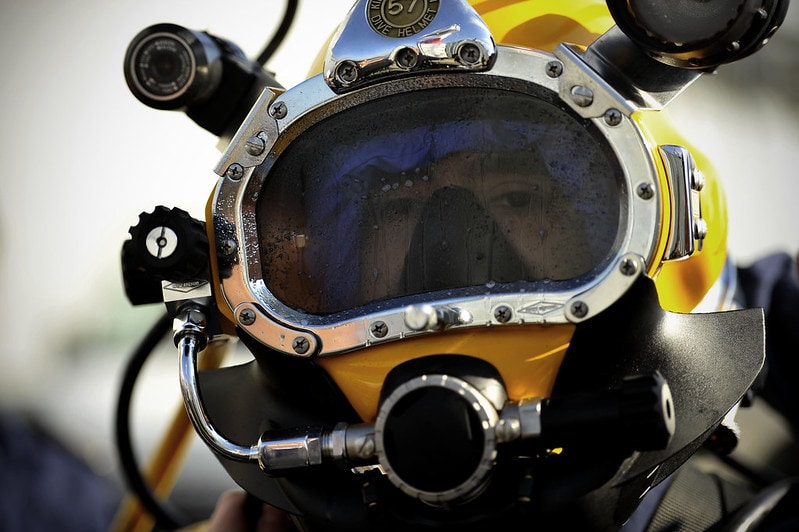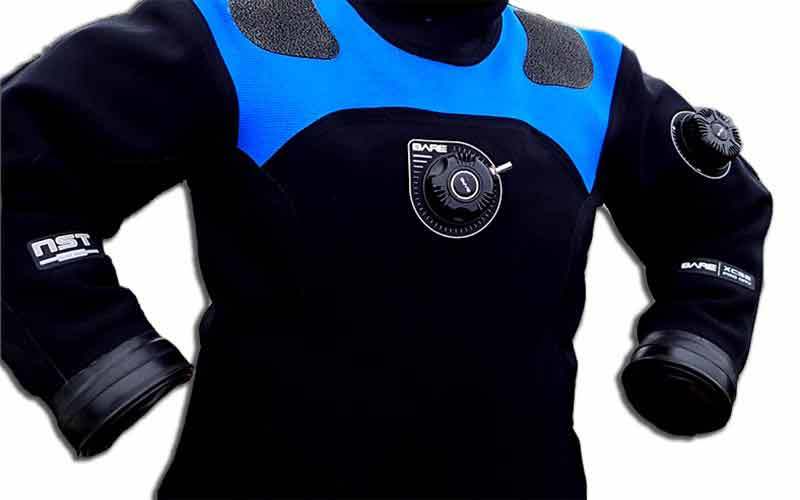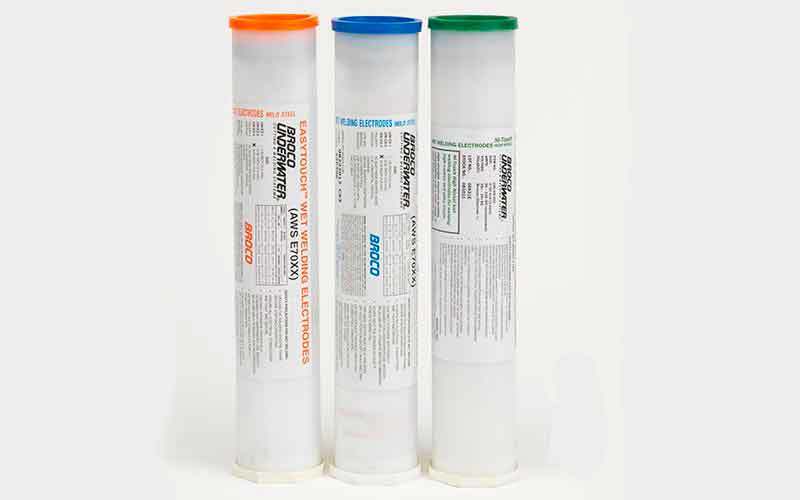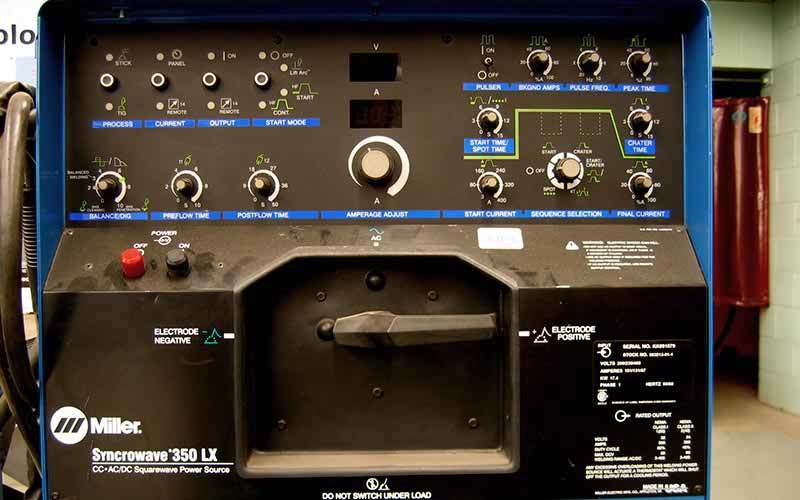Also, because most underwater welders weld topside, it’s important to understand how their tools function differently in a watery environment.
To properly weld underwater, a commercial diver uses five main tools:
- Diving helmet
- Accessories
- Diving suit
- Electrodes
- Stinger
- Power supply
Let’s take a look at each one:
1. Diving Helmet: The Eyes & Ears of Hyperbaric Welding Projects
Underwater welders need a reliable diving helmet for their work.

On the surface, welding helmets (hoods) protect the welders’ eyes and face during a weld job. Underwater welding helmets serve this purpose, in addition to allow breathing for the welder-diver.
Most use the same diving helmet that they would on a regular commercial dive, with one addition:
A welding screen that attaches to the front of their mask for eye protection.
Some of these welding screens flip up or down like a welding hood, and they come in all different shades.
Diving Helmet Types
Underwater welders use one of these helmets depending on the project:
Open Circuit: This helmet utilizes a non-return gas valve, anti-fogging lens, side weights, internal cushion and many other modern characteristics. It’s the standard and most popular helmet for commercial divers. Because it uses a non-return valve, your exhaled air is expelled into the water.
Reclaim: This helmet type follows the same principles as the Open Circuit, but it recycles the diver’s exhaled gas and pumps it back into the system at the same ambient pressure.
Free-Flow Helmet: Outfitted with the most simplistic design, this helmet is characterized by a larger transparent visor for the greater visibility. Because of its simplicity, divers can take it apart and put it together again with just a screwdriver and wrench. It’s used mainly in hazardous materials and for shallow water.
Wet welding only uses surface-supplied air (SSA), so it’s worth mentioning that the equipment used in SSA is specialized and only used by professionals. SSA (as opposed to SCUBA) is crucial for underwater welders because it allows communication with the surface team who are operating the welding machine.
2. Underwater Welding Accessories: Vital Attachments to Use
In addition to their helmet, welder-divers will use these diving accessories:
- Diving Knife: As the whip is to Indiana Jones, so a knife is to welder-divers. It’s a tool for every situation, whether they need to cut into project material, wedge open a door or free themselves from an entanglement. A diving knife does the job.
- Umbilical cord: This is where gas is pumped from the diver to and from the surface.
- Harness – To keep the diver buoyant and in one place while doing his or her work.
- Gas Panel and Compressor: A qualified team monitors gas gauges and keeps a steady supply of air coming to the diver(s) below. Divers also monitor these directly. Most use a low pressure gas because of its low maintenance virtually unlimited air supply.
- Bailout Gas: Used for emergency situations, this gas is normally carried by the diver as a secondary gas supply in case the SSA equipment malfunctions. It comes in the form of a small SCUBA tank.
- Knife Switch: Not the same as a diving knife. This is used when using electric equipment underwater like wet welding. Built as a simple lever, it controls the flow of electricity from topside to power your tools.
3. Diving Suit: Flexible Armor for the Job

What’s the difference between an underwater welder’s diving suit and a SCUBA diver’s suit?
Depends on the activities they’re involved in.
Most commercial divers use a drysuit, as it provides superior climate control and more protection than a wetsuit.
Drysuits are either neoprene, rubber or shell, depending on the environment you’re diving into. However, as an added external layer of protection, some underwater welders wear coveralls over the top of their suits.
If any molten metal hits their suit directly, it can burn through it. Coveralls keep this from happening.
To protect their hands, welder-divers wear thick, rubber linemen’s gloves over several pairs of latex.
To keep water from getting into the gloves, they may snap a rubber band around the wrist section.
4. Waterproof Electrodes: The Right Coating Goes a Long Way

The electrode is arguably the most important part of an underwater welder’s tools since it provides material for the weld. There are many sizes and materials to choose from, starting at the small 1/8 inch underwater welding rods that work on mild steel to the slightly larger 5/32 stainless steel rods.
Here’s where the magic happens.
The key difference between topside and underwater welding is the coating; underwater electrodes should be extremely water-resistant. Some welder-divers still coat their own electrodes, but most only last a few hours.
A representative at Broco-Rankin informed us that their electrodes can sit in the water for up to 24 hours and still maintain their water-resistant coating.
They work well down to depths of 33 feet. Below that level, the pressure can cause more porosity that can damage the structural integrity.
Water Resistant Coating: The longer it can hold up in a hostile marine environment, the better.
High Strength Yield: Better quality material in the electrode provides a higher density weld that will last longer. Typical weld diameters are 1/8 and 5/32 inches.
5. Underwater Stinger: Less is More

Stingers hold the electrodes, and they’re primarily made of lightweight plastic materials to reduce the possibility of cramps and fatigue.
Designed for simplicity, stingers don’t need many extra features to function underwater.
Underwater welders who train with a specific stinger usually prefer the same type on the job, even if there’s a newer one on the market. “Stick with what you know” is the general consensus. This is probably due to feeling other parts of their job are unpredictable.
However, up-to-date equipment helps drive a safer, more efficient operation and can often decrease overall costs. Such equipment literally makes these types of tools – especially underwater torches – cutting edge.
A quality underwater welding stinger like the Broco BR-21 stinger has the following characteristics:
- Insulated: Saltwater is a high conductor of electricity, and welder-divers need all the protection they can get. If the stinger is well insulated, it will keep the welder-diver from feeling most of the current, even at 200 amps.
- Ergonomic and lightweight: The bigger the welding project, the more an underwater welder needs a stinger he/she can hold for a longer period of time.
- Angled Correctly: The stinger needs the perfect hole and notch where underwater welders can insert the electrode. This allows optimum use in a variety of welding positions and visibility.
6. Underwater Welding Machine: Amperage & Current Matters

Make it hot.
Counter to most topside welding processes, controlling underwater welding equipment is a partnership of the divers below and the control team on the boat.
Just before the welder-diver is ready to start the weld, he or she will communicate via radio to the control team.
This signals them to turn the underwater welding machine to the correct amperage.
The required power greatly depends on the size of the electrode, according to a representative from Miller.
Because the vast majority of welding is done topside, few (if any) companies produce welding machines made specifically for underwater welding use.
Some require additional steps to change it to a safe output mode in underwater use, such as taking out a coil from the inside of the machine.
These are qualities to look for in an underwater welding power source:
- Consistent and Stable Power: A good machine doesn’t fluctuate in amps without someone turning that knob; even with longer power cables, it should maintain a good, continuous flow.
- Duty Cycle: This represents the time in which an underwater welder can operate underwater welding equipment at maximum amperage (power). If a machine operates at 275 amps for a 60% duty cycle, this means you can weld full-throttle for 6 minutes out of 10 (shut the output off for 4 minutes). Other machines can operate at a higher level – once again, power needs are dependent mostly on the electrode type being used.
- DC not AC: In the water, all welding equipment should be powered via direct current, not alternating current. Direct current flows in one, constant direction. It’s a better alternative to AC when used underwater. Welder-divers use straight polarity (negative), which provides a longer life for the electrode holder (usually).
Armed & Ready: Underwater Welding Equipment
The underwater welding equipment above come with a sizable cost, but most welder-divers are employed by a company that already possesses this equipment.
If you don’t have this luxury, you can base your tools’ expenses on your income and invest as you’re able. Tax-deductible expenses can greatly help you succeed as a maritime subcontractor.
Besides the stinger and electrode, the underwater welder’s tools is used for other purposes besides underwater welding.
Still, it’s important to know the characteristics of this underwater welding equipment to make sure you’re staying informed and utilizing the best for underwater welding jobs.

